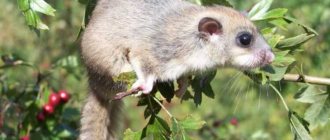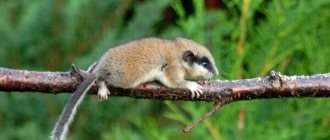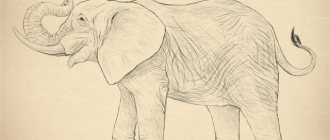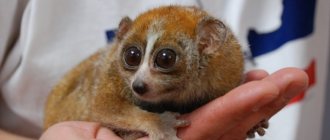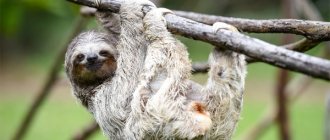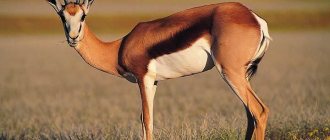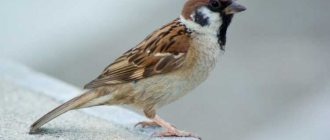Review author: “ZooVita”
At first glance, this mysterious animal from the order of rodents evokes tenderness and keen interest. These furry animals are so small that they fit completely into the palm of an adult. You can recognize a dormouse by its long and fluffy tail, as well as by its specific fur color.
Photos of forest dormouse can be found on the pages of reference books of fauna and wildlife representatives.
General characteristics of the forest dormouse
These rodents look like a field mouse or even a squirrel (the fluffy tail is especially similar).
The maximum size that a dormouse can reach is about 30 cm including its tail. Moreover, the tail is much longer than the body of the forest animal itself. The weight of the dormouse does not exceed 35-40 grams.
Distinctive features of the forest dormouse
- Elongated muzzle shape.
- The presence of vibrissae - thin whiskers located on the muzzle. The long tactile fibers have a powerful muscle base, allowing the sleepyhead to explore its environment.
- The rodent's eyes are large relative to the body, allowing the dormouse to navigate in the twilight.
- The hind legs are significantly larger than the front ones, which determines the nature of the animal’s movement. Flexible front fingers allow the dormouse to freely climb trees and climbing vines, firmly clinging to protruding parts with the phalanges of its fingers.
- Many external signs can change depending on the nature of the forest animal’s diet and lifestyle. Owners of pet dormouse who provide proper care for their pet should remember this fact. A healthy rodent has shiny fur and an active, peaceful character.
You should know that the tail serves not only as an adornment for a forest dweller, but is also an organ of balance. The fur and coloring of the tip of the tail can signal the mood of its owner.
Reddened skin and fluffy fur indicate fear or aggression of the animal. This amazing fact is associated with the peculiarities of the structure and blood supply of the caudal region.
The graceful animal weasel: a pet or a fierce enemy?
Weasel is an animal (photos of the animal are presented in this article) with a flexible, thin and elongated body.
She has an oblong head, a long neck and small round ears. This is the smallest representative of the weasel family. The length of its body is no more than 25 cm, of which about 5 cm is the tail, and at its base there are glands that secrete an unpleasant-smelling liquid. The weasel animal in the summer is dressed in brownish-brown fur with a white neck, belly and chest. In winter, she dresses in a pure white outfit. The weasel is mainly nocturnal, but if it does not see danger for itself, it can hunt during the day. She runs, swims, jumps and climbs trees perfectly, but her main strength lies in her ability to climb through the narrowest holes and crevices. For example, she easily chases mice into their own holes. This mammal also feeds on all kinds of birds, their eggs and chicks, as well as lizards, snails, various insects, frogs and fish. The weasel animal even hunts vipers, copperheads and grass snakes. And if its main diet is reduced for some reason, then the weasel attacks animals larger than itself. These can be rats, hamsters, young hares and rabbits, gophers, hazel grouse, partridges and black grouse.
The weasel animal lives under piles of stones, in tree hollows, and in ruins. Sometimes it can settle in rat holes or under washed-out shores. In winter, it is attracted to warmer places: attics and sheds of rural buildings, and it can also be found on the outskirts of the city. From May to June, the female gives birth to 5 to 7 cubs. This happens in a place hidden from prying eyes, which is necessarily covered with hay, leaves or straw. The mother is very kind to her babies. She feeds them milk for a long time, and then brings them live mice for several more months. But if her children are disturbed, she will immediately move them to another place.
And now the grown cubs begin to leave the nest. Their mischievous and cheerful faces alternately appear from it and inspect the area. If everything is calm around, then the kids come out one after another, playing games on the green grass. The weasel animal has many natural enemies - these are all mammalian predators that are larger than it, and birds of prey.
In its natural habitat, the weasel lives 8-10 years, but in captivity its lifespan does not exceed 6 years. Adults tolerate the loss of freedom very hard, so for taming you need to take a young animal that is still with its mother. In this case, the weasel quickly gets used to its owner and becomes the most gentle animal that lives up to its name. But for rural residents, it is almost the most fierce enemy, as it exterminates poultry and rabbits. In the old days, a goat was brought to the barnyard to see her out. For this purpose, the oldest was chosen. After 2-3 days, the small predator left its favorite place.
You can also get rid of the uninvited “tenant” with the help of windmills. The fact is that all underground animals react very sensitively to an earthquake, and the slightest vibrations transmitted through the pole into the ground force moles, rats, shrews and mice to leave their shelters. Weasel is no exception. The animal (how to catch it is of interest to many) can be caught using a device such as a scoop, and sparrows are used for bait. Although many gardeners, beekeepers and hunters catch this animal specifically in the wild in order to release it into their undergrounds, cellars or barns to exterminate mice and rats.
Habitat of the forest dormouse
You can meet the dormouse in Asia, a number of European countries, and in some regions of Russia. Basically, the distribution area is associated with the rodent’s adherence to a temperate climate.
Sonya prefers to settle mainly in deciduous forests, where there are a large number of oak trees, dense bushes, and multi-tiered green spaces. Furry forest dwellers build shelters in old hollows, bird nests, and in large crevices between the bark and tree trunk.
Thickets of bushes, the branches of which have sharp thorns and thorns, often provide reliable protection against natural enemies. These animals can build their own nests, using bark, branches, leaves, down, and bird feathers as building materials.
Reproduction of common tupaya
Most often, tupai form monogamous pairs, but in captivity they are characterized by polygamy. And in Singapore, common tupai are also polygamous, with one male's territory covering several females' territories.
Reproduction occurs throughout the year, with a peak occurring from February to June. In August-November, practically no babies are born.
Pairs of common tupaya breed throughout the year.
Pregnancy in common tupai lasts 46-50 days. The litter most often contains 2-3 blind babies who weigh 10-12 grams. The eyes open around the 20th day of life. After 36 days they become independent and can leave their parents. Puberty occurs at 3 months. At 4.5 months, females are already capable of reproduction. Due to the short duration of pregnancy and the rapid maturation of individuals, tupayas reproduce quickly.
Common tupayas take interesting care of their offspring. The babies are in a separate nest, specially built by the male. The female devotes little time to the cubs: she visits them for only 10-15 minutes a day. At one time, each baby sucks 5-15 grams of milk. This is where caring for the offspring ends. Without scent marks, they cannot identify their babies at all. After 36 days, the young individuals move to the nest with their parents, and a few days later they settle.
Tupai lead a semi-arboreal lifestyle, spending most of their time on the ground, where they rummage through litter in search of food.
Nutrition of the forest dormouse
The predominantly nocturnal lifestyle, the presence of excellent hearing, as well as the metabolic characteristics of the inhabitant of deciduous forests determine the wide composition of the diet.
Dormice are absolutely unpretentious in food. What does the forest dormouse eat:
- The consumption of a variety of cereal crops is typical for this representative of rodents, as well as for all representatives of the order.
- The fluffy animal is not at all averse to eating the seeds and fruits of berries, fruit trees, and berry bushes (raspberries, hawthorns, blackberries, rose hips). It is plant foods that become the main source of protein and vitamins for dormouse.
- In hotter regions, animals eat a variety of fruits.
- At the beginning of spring, when there is a lack of food sources, the diet is replenished with roots, young shoots of plants, and the bark of young trees.
They do not avoid dormice and animal food, actively consuming insects, larvae, and mollusks. Forest inhabitants can destroy bird nests, destroy eggs, eat young chicks and even small lizards.
Lifestyle of the forest dormouse
Dormouses are exclusively nocturnal. They prefer to move only on the ground, but some subspecies prefer the arboreal-terrestrial nature of movement. It is not typical for the forest dormouse to form a strong family and live in groups. Males find a pair only during the mating season, subsequently leading a solitary lifestyle.
Throughout the summer-autumn period, dormice actively gain weight, accumulating subcutaneous fat. With the onset of the first cold weather, furry rodents hibernate. An important feature of metabolism - the ability to reduce body temperature to 4 degrees during sleep - is decisive in the seasonal hibernation of the dormouse.
The character and behavior of the animals shows a unique tendency to maintain cleanliness. Dormouses can spend several hours thoroughly cleaning their fur from debris, debris, and dirt. Today, the question of how long the forest dormouse lives has been finally resolved - up to 6 years.
Appearance of common tupaya
The body length of the common tupaya is 15-22 cm, while the length of the tail can be almost the same. Body weight ranges from 160-260 grams.
The muzzle is elongated. Unlike other types of tupaia, the common tupaia has sparser fur.
The color of the back can be reddish, ocher, olive or almost black. The color of the abdomen varies from whitish to dark brown. There may be light stripes on the shoulders.
Common Tupaia (Tupaia glis).
A characteristic feature of this species is the shorter lower part of the auricle compared to the upper. There is a hairless area on the nose that is cut straight, while on the rest it is pulled back a little. The tail has long hairs.
There is a specific skin gland on the throat; some insectivores have such glands.
Enemies of the forest dormouse in nature
The main enemies of the forest dormouse are owls. These birds of prey hunt exclusively at night, attacking and capturing small rodents with their sharp talons.
Among birds, hawks and kites are also dangerous. On forest roads, small animals should avoid encounters with foxes, stoats, dogs and cats.
The greatest competition in terms of nutrition comes from gray rats. Extermination of the rodent by humans, trapping, and the use of pesticides and poisons on agricultural plantations led to the inclusion of the forest dormouse in the Red Book.
Keeping forest dormouse at home
Keeping forest dormouse at home is a fairly common occurrence today. With proper care and an optimal diet, the animals delight their owners with a beautiful fluffy tail, playful mood and friendly character.
To keep a pet, you will need to purchase a cage of sufficient size and special balanced food mixed with vitamins and minerals.
It is important to maintain constant hygienic care of the cage and the animal itself to avoid possible infectious diseases. If necessary, you can use specialized cereal additives (in zoological stores).
Social relations in the family
Tupai live alone and sometimes in groups. They strictly protect their plots. Fights often occur between male tupayas, ending in death. Males and females do not fight.
The diet of common tupai consists of fruits and insects, and occasionally small vertebrates.
Tupaia family groups consist of parents and their young, with adult males dispersing and females often remaining with their parents. They always feed alone. They communicate with each other using sound signals, and sometimes use other signs, for example, tail movements. They also tend to leave odorous marks using glands located on the stomach and chest.
